How To Create Effective Video Ads & Cash In on the Results
After bouncing around tech start-ups and university literature programs, Joe has finally settled down as Billo’s Head of Content. Joe now spends his days writing ads about ads, teaching clients how to craft killer content, and combing through our web copy with a bold red Sharpie.
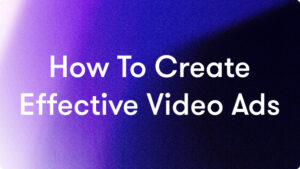
You love them, and you hate them. They’re in your face and all over the place. They rule the Web—video ads.
Video ads have infiltrated the internet and now live not quite rent-free on almost every single page, platform, and channel. There’s a reason for that: video ads work and outperform most other ads.
Unlike a static image or billboard, video ads literally speak to their viewers. Combine that advantage with advanced targeting or tracking so video ads can hit their intended demographic, and you get some serious advertising magic.
Video ads definitely work, but what kind works best is up for debate. Ultimately, a winning video will check some boxes, and a productive ad’s performance can be measured.
How to create video ads that will pique the interest of and engage your followers? What should you include in your video ads to encourage clicks and inspire sales? How to measure if your video ad is making an impact and worth the cost of production?
Below, find everything you need to know about creating compelling (and interesting) video ads from start to finish. Learn how to build an ad that gets people talking and makes your audience go “wow,” all while driving up your numbers. Let’s get started.
Examples of Winning Video Ads
Pets
View this post on InstagramA post shared by Pet Food Australia (@pet_food_australia)
Home appliances
Cosmetics
Health, wellness, and fitness
Apparel
Kids and babies
Apps and digital services
Food
Platforms
TikTok Ads Examples
Facebook UGC Examples
Understanding the Power of Video Ads
We all know one or two ads by heart. Video advertising has proven to be an exceptionally effective medium for conveying messages, evoking emotions, and leaving a lasting impact on viewers.
The psychology behind video advertising
At its core, video advertising taps into the psychology of visual and auditory stimuli to create a rich, immersive experience for viewers.
Human brains are wired to process visual information more efficiently than text, and the combination of visuals, sound, and motion in video ads creates a multisensory engagement that is hard to replicate through other mediums.
This engagement triggers emotions, fosters connection, and helps viewers form stronger memories of the content they’ve consumed.
The power of storytelling through video allows brands to convey their messages in a way that resonates deeply and authentically with their target audience.
Benefits of using video ads over other formats
Video ads offer a range of advantages that set them apart from other advertising formats.
One of the key benefits is their ability to convey complex messages in a succinct and engaging manner. Through visual storytelling, brands can communicate their value propositions, product features, and brand narratives in a matter of seconds, capturing viewers’ attention in a world where attention spans are increasingly limited.
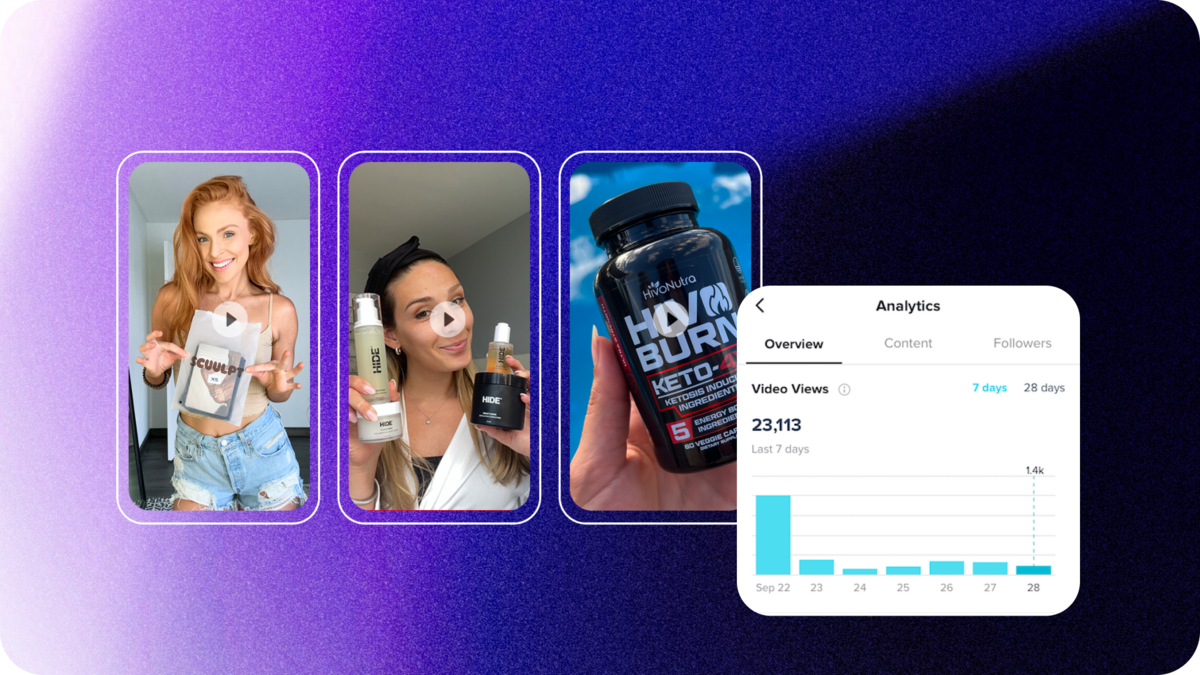
Video ads also have the potential to evoke emotions and create memorable experiences. The combination of visuals, music, and narrative can trigger a wide range of emotional responses, allowing brands to establish connections with viewers on a personal level.
Whether it’s humor, empathy, excitement, or nostalgia, emotions play a significant role in driving consumer behavior and fostering brand loyalty.
Statistics and trends highlighting the effectiveness of video ads
The effectiveness of video ads is not merely anecdotal; it’s backed by a wealth of statistics and trends that showcase their impact.
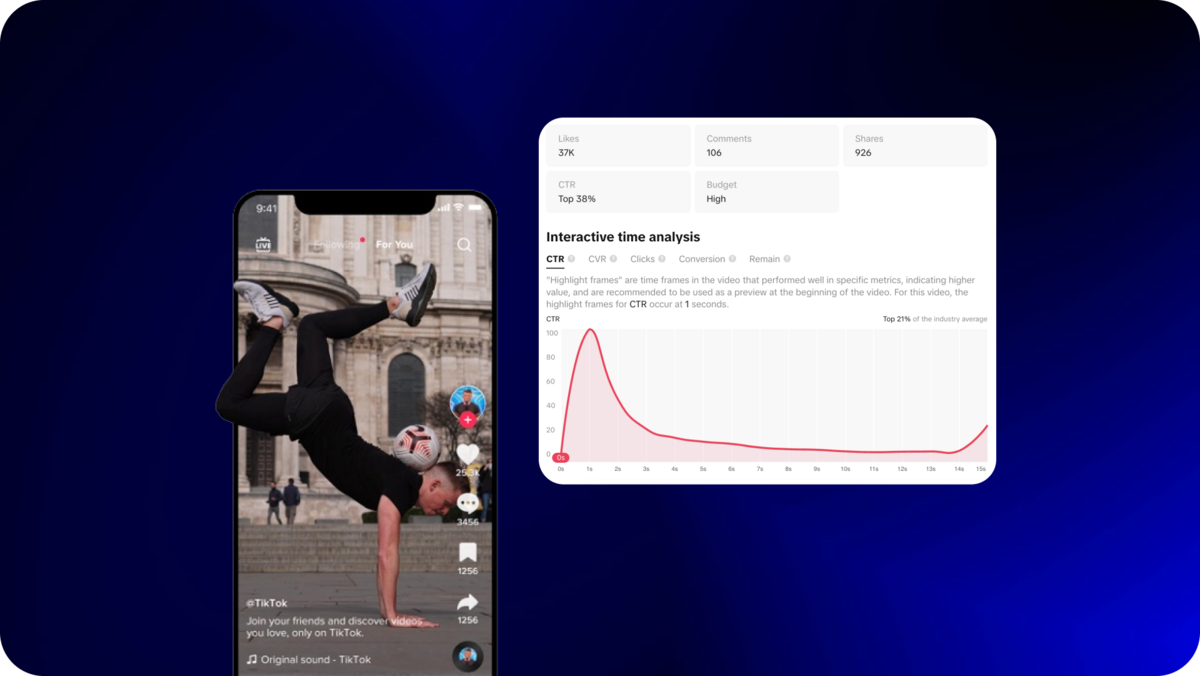
According to recent studies, video content generates higher levels of engagement compared to static images or text-based content.
In fact, social posts with video content tend to receive significantly more shares, comments, and likes, indicating a higher level of user engagement.
Also, the rise of platforms like TikTok, Instagram Stories, and YouTube Shorts underscores the growing demand for short-form video content. These platforms have become breeding grounds for viral video content, giving brands the opportunity to reach massive audiences in a short amount of time.
The rise of mobile consumption has fueled the popularity of video ads, as mobile users find videos more accessible and enjoyable while on the go.
Learn more about which types of video ads perform best on TikTok
Defining Your Video Ad Objectives
To create an effective video ad campaign, it’s crucial to start with a clear understanding of your objectives. Defining your video marketing objectives serves as the base upon which your entire campaign will be built.
Identifying your target audience
Understanding your target audience is a big deal! It’s the cornerstone of any successful marketing effort, and video ads are no exception. Your video ad should resonate with the specific group of people you want to reach, engage, and convert into customers.
Take time to analyze the demographics, psychographics, behaviors, and preferences of your potential audience. This information will help you tailor your video ad content to speak directly to their needs and desires.
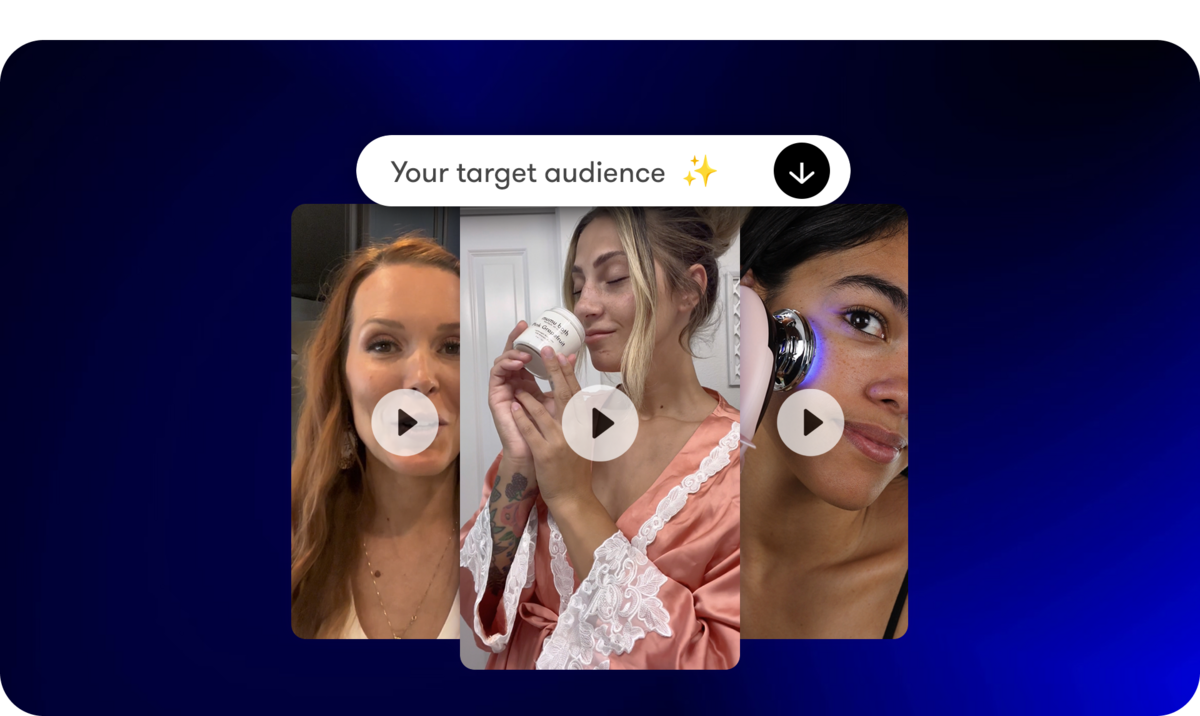
Creating a detailed buyer persona—a semi-fictional representation of your ideal customer—can be immensely helpful. Imagine what your perfect customer looks and acts like.
Consider and think on factors such as age, gender, socio-economic status, location, interests, pain points, and aspirations. The better you know your audience, the more effectively you can craft a video ad that resonates with them on a personal level.
Setting clear, concise, and measurable goals for your video ad campaign
How to know if your ad is successful? Goals provide direction and purpose to your video ad campaign. To ensure your campaign’s success, set clear and measurable objectives.
These goals will depend on your specific marketing needs, but common video ad objectives include the following:
- Brand awareness: Increasing your brand’s visibility and recognition among your target audience.
- Engagement: Encouraging likes, shares, comments, and other interactions with your video ad.
- Lead generation: Collecting contact information or driving traffic to landing pages to capture potential customers.
- Conversions: Driving sales, sign-ups, or any other desired actions that contribute to your bottom line.
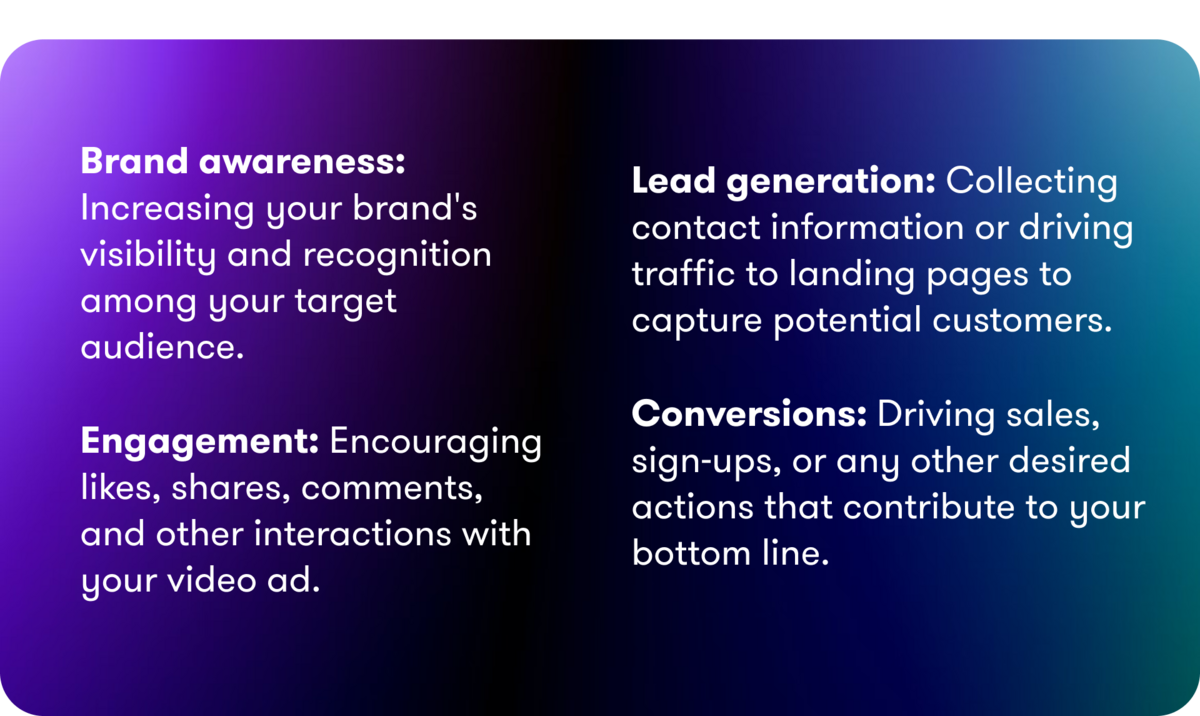
By setting quantifiable targets, such as a certain number of views, engagement rate, or conversions, you can track or measure the progress of your campaign and make informed adjustments as needed.
Aligning objectives with your overall marketing strategy
Your video ad campaign shouldn’t exist in isolation—it should be seamlessly integrated into your broader marketing strategy.
Your video ad objectives should align with your overall business goals and marketing initiatives. This ensures that your video ad campaign isn’t just a one-off effort but contributes to the long-term success of your brand.
Consider how your video ad fits within your customer journey. Are you targeting users who are just discovering your brand, or are you nurturing leads further down the funnel?
Align your message, tone, and call-to-action with the stage your audience is at in their purchasing journey.
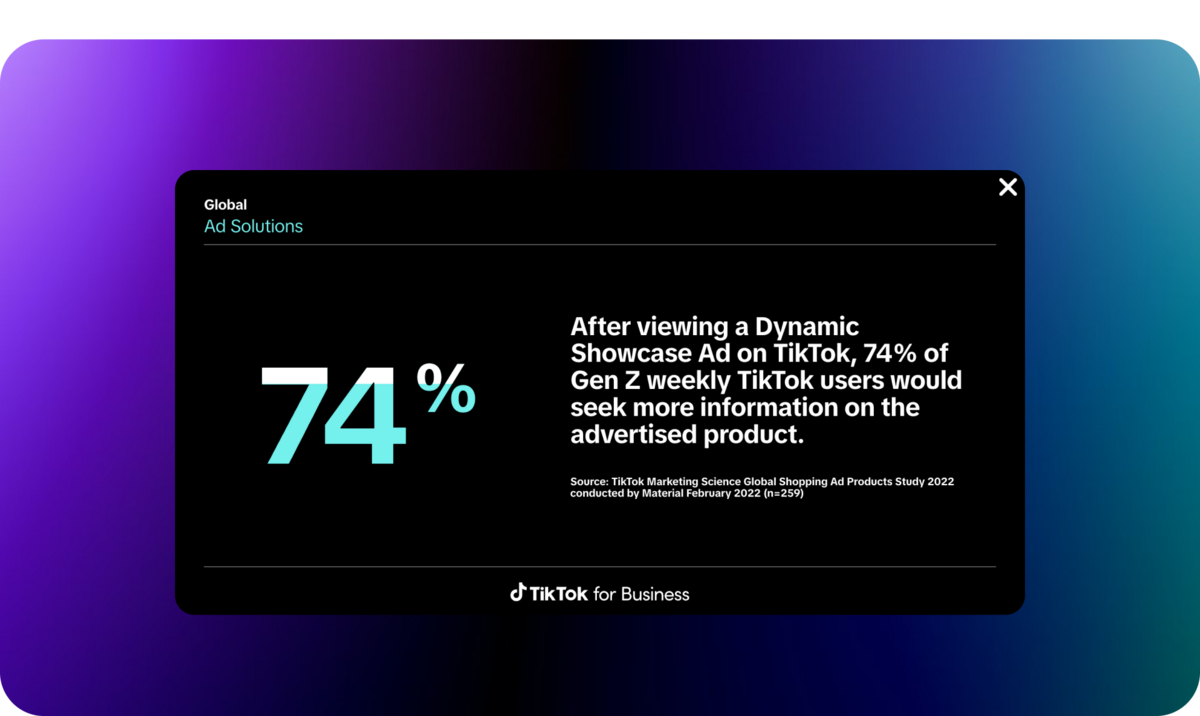
Incorporating your brand’s unique value proposition and messaging into your video ad will help reinforce your brand identity and make your ad more memorable.
Crafting Compelling Video Ad Content
Creating compelling video ad content is an art that requires a careful blend of creativity, strategy, and execution.
The critical elements of a successful video ad
- Story: Every great video ad has a story at its core. A well-crafted narrative helps viewers connect with your brand, product, or message on a personal level. A compelling story can be humorous, heartwarming, inspirational, or informative—what matters most is that it resonates with your target audience.
- Visuals: The visual aspect of your video ad is often the first thing that captures viewers’ attention. Video editing is important! Visuals should be engaging, relevant, and visually appealing. Consider using a mix of dynamic shots, animations, and graphics to convey your message effectively.
- Sound: Sound design plays a crucial role in setting the vibes or tone and enhancing the emotional impact of your video ad. Whether it’s background music, sound effects, or voiceovers, the auditory elements complement the visuals and reinforce the message you’re conveying.
- Emotion: Emotion is a powerful driver of consumer behavior. Whether it’s laughter, empathy, excitement, or nostalgia, evoking an emotional response in viewers can make your ad memorable and create a lasting connection.
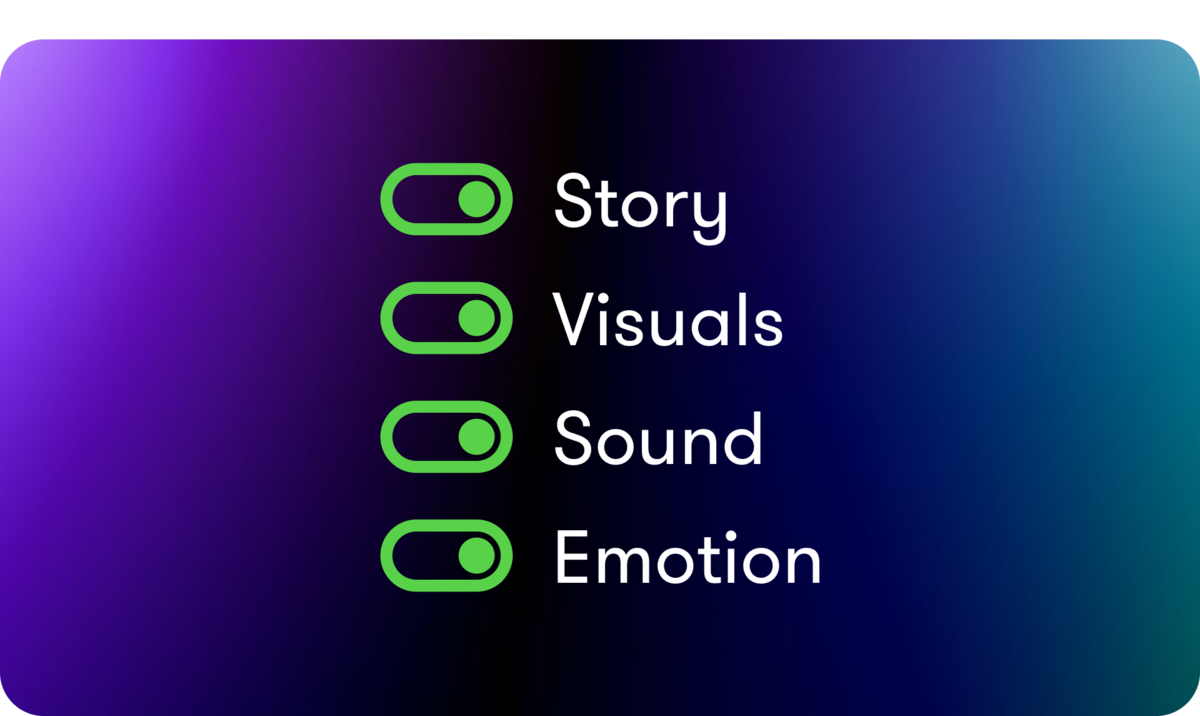
Techniques for creating engaging narratives and storytelling
- Hook your audience: Start your video ad with a compelling hook that grabs viewers’ attention within the first few seconds. Use an intriguing question, an unexpected scenario, or a relatable situation to pique curiosity.
- Show, don’t tell: Visual storytelling is about showing the benefits or solutions your product offers rather than explicitly stating them. Use imagery and actions to convey your message.
- Conflict and resolution: A classic storytelling technique involves introducing a conflict or challenges that your product or service can resolve. This builds tension and keeps viewers engaged until the resolution is presented.
- User-generated content (UGC): Incorporating user-generated content or testimonials can add authenticity to your video ad and showcase real experiences with your brand.
Tips for choosing the right visuals, music, and voiceovers
- Visuals: Select visuals that align with your brand’s identity and the emotions you want to evoke. Use only high-quality images and videos that are well-lit, properly framed, and visually appealing.
- Music: The right music can enhance the mood of your video ad. Choose music that complements the narrative and adds emotional depth. Ensure the music doesn’t overpower the message or distract from the visuals.
- Voiceovers: If using a voiceover, choose a voice that matches your brand’s tone and resonates with your audience. The voiceover should deliver the message clearly and maintain viewer engagement.
- Consistency: Maintain visual and auditory consistency throughout your video ad. A cohesive presentation enhances the professional quality of your content.
Choosing the Right Video Ad Platform
In the dynamic landscape of digital advertising, selecting the appropriate platform for your video ad is a strategic decision that can significantly impact its reach, engagement, and effectiveness.
Overview of different platforms for video ads:
- Social media platforms: Social platforms like Facebook, Instagram, Twitter, and TikTok are popular hubs for video content consumption. They offer diverse user demographics and engagement opportunities through features like comments, likes, and shares.
- Streaming services: Streaming platforms like YouTube, Twitch, and even newer additions like Instagram Reels and YouTube Shorts provide avenues to reach audiences through short-form video content. YouTube is the second-largest search engine globally and an excellent platform for long-form video content.
- Websites: Video ads can be placed on websites through various formats, such as in-banner videos, pre-roll ads, and interstitial ads. These can be tailored to match the website’s content and audience.
- Other platforms: Depending on your niche and target audience, other platforms like LinkedIn (for B2B), Snapchat, and even emerging platforms can be viable options for video ad placement.
Matching platform selection with your target audience and goals
Understanding your target audience and campaign objectives is pivotal in choosing the right platform. Consider factors like demographics, interests, and behaviors of your audience.
Different platforms attract varying age groups and user behaviors, so aligning your ad with the right platform ensures it reaches the people most likely to engage with it.
For instance, if you’re targeting a younger demographic, platforms like TikTok and Instagram might be more effective due to their popularity among Gen Z users.

On the other hand, if you’re aiming for a professional audience, LinkedIn might be the preferred platform.
Platform-specific tips and best practices for video ad placement
- Social media:
- Create platform-specific content that matches the tone and style of each platform.
- Utilize features like Instagram Stories, TikTok challenges, or Twitter polls to increase engagement.
- Leverage targeting options offered by each platform to ensure your ad reaches the right audience.
- Streaming services:
- Tailor your content to the platform’s audience. For example, YouTube viewers may prefer longer, educational content, while TikTok users engage with shorter, entertainment-focused videos.
- Invest in quality production, as visual and audio quality is crucial on streaming platforms.
- Websites:
- Opt for ad placements that are contextually relevant to the website’s content.
- Consider user experience and avoid intrusive ads that might lead to negative impressions.
- Other platforms:
- Research emerging platforms and assess their potential for your specific niche.
- Keep an eye on trends and shifts in user behavior to better stay ahead of the curve.
Designing for Different Video Ad Formats
In the era of diverse digital platforms and user preferences, designing commercials and video ad content that adapts seamlessly to various formats is essential for maximizing your campaign’s reach and engagement.
Creating videos optimized for different platforms (landscape, portrait, square)
Different platforms have varying display dimensions, and creating video content that fits these dimensions is crucial for delivering a visually pleasing and effective experience to your viewers.
The main formats you’ll encounter are landscape (horizontal), portrait (vertical), and square.
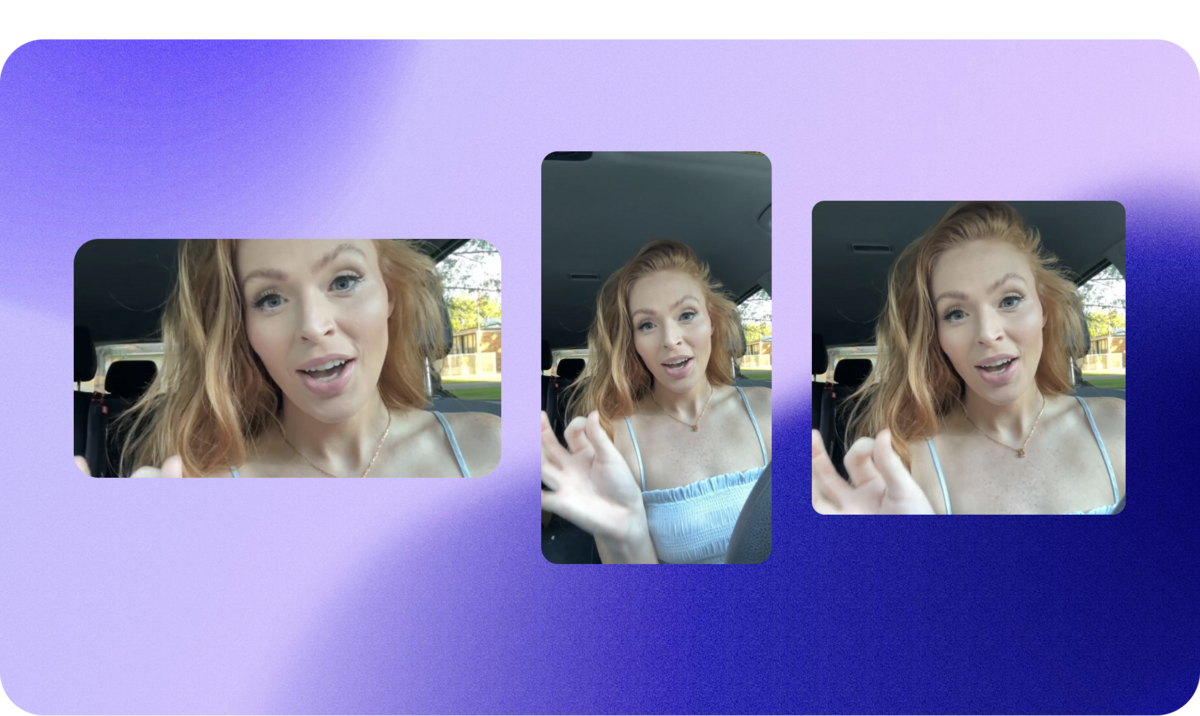
For example, Instagram Stories and TikTok primarily utilize vertical video, while YouTube and traditional TV ads are often in landscape format. Creating content in square format can provide flexibility, as it’s more adaptable across platforms.
Tailoring your video to the platform’s preferred format enhances user experience and makes your content appear native to the platform.
What are aspect ratios, and why do they matter
An aspect ratio references the proportional relationship between an ad’s width and height. It’s expressed as a ratio, such as 16:9 (widescreen), 9:16 (vertical), or 1:1 (square).
Aspect ratios influence how your video is displayed on different devices and platforms.
The aspect ratio you choose impacts how your content is perceived and whether it fits the viewer’s screen without cropping or stretching. A mismatched aspect ratio can lead to a better viewing experience and help engagement.
By selecting the appropriate aspect ratio for each platform, you ensure your video ad looks its best and retains its intended message.
Adapting content to various time constraints (short-form, long-form)
Different platforms and user behaviors call for varying video lengths.
Short-form videos are ideal for platforms like TikTok, Instagram, and Snapchat, where attention spans are limited. These videos are typically 15 to 60 seconds long and require concise, impactful storytelling to capture viewer interest quickly.
Long-form videos, on the other hand, have a place on platforms like YouTube, where viewers are more willing to invest time. These videos can range from a few minutes to even hours, providing an opportunity to delve deeper into complex topics, narratives, or tutorials.
Ensuring video ad responsiveness across devices
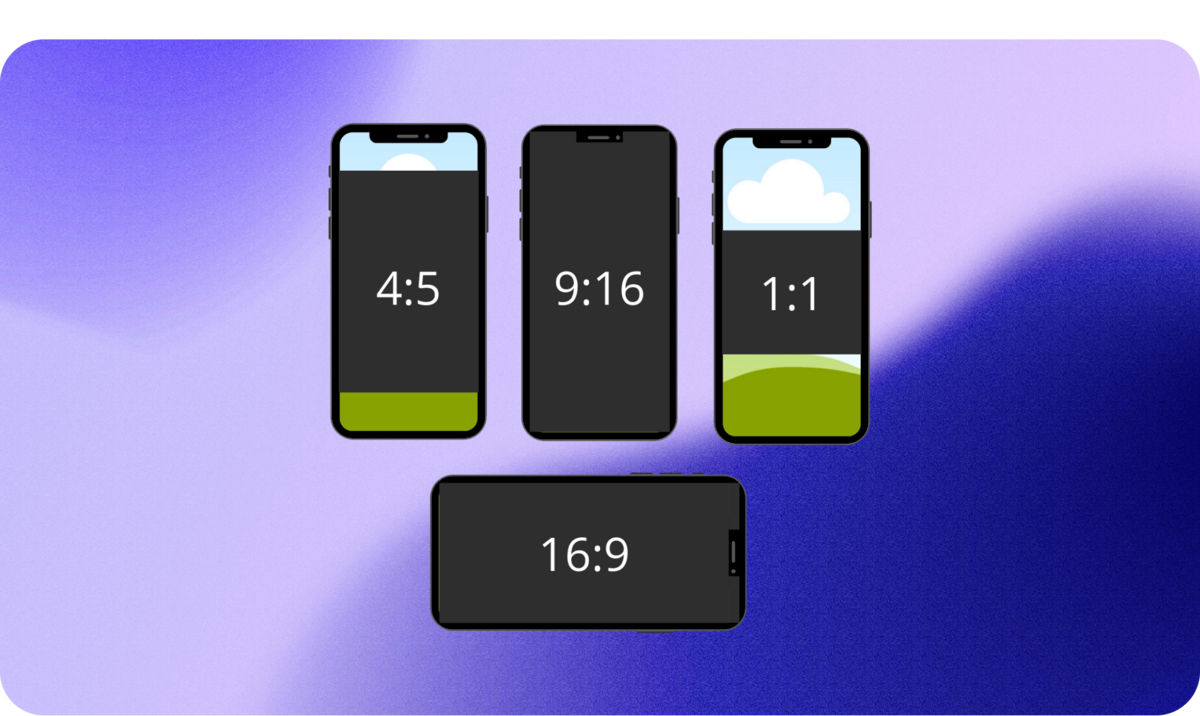
In a mobile-first world, ensuring that your video ad content is responsive across devices is paramount.
Viewers engage with content on various screens, from smartphones and tablets to laptops and desktops. Responsive design ensures that your video ad scales appropriately, maintaining legibility and visual appeal across all screen sizes.
Using adaptive layouts, scalable typography, and flexible visual elements can prevent content from appearing distorted or unreadable on different devices.
By providing a consistent and enjoyable viewing experience, you enhance your chances of capturing your audience’s attention and delivering your message effectively.
Video Production and Editing
Creating a compelling video ad involves a combination of careful planning, skilled execution, and meticulous editing.
Pre-production checklist:
- Script: A well-crafted script forms the foundation of your video ad. It outlines the dialogue, narration, and vital visual cues. A clear script ensures your message is communicated effectively.
- Storyboard: Creating a visual storyboard helps you visualize the sequence of shots and transitions. It’s like a roadmap that guides your filming and editing process.
- Shooting plan: Plan each shot in advance, considering camera angles, lighting, and composition. A shooting plan reduces wasted time and resources during filming.
- Equipment: Use quality equipment, including cameras, microphones, lighting, and stabilizers. The right tools contribute to professional-looking results.
Tips for shooting high-quality video footage
- Lighting: Proper lighting is essential for clear, vibrant footage. Natural light or diffused artificial light can work wonders. Avoid harsh shadows and overexposed areas.
- Composition: Compose your shots thoughtfully, adhering to the rule of thirds and creating visual interest. Experiment with different angles to add dynamism.
- Audio: Good audio quality is often overlooked but crucial for viewer engagement. Invest in external microphones to capture clear sound.
- Stability: Use tripods or gimbals to ensure stable footage. Shaky camera work can be distracting and negatively impact the viewer’s experience.
Introduction to video editing tools and basic editing techniques
After filming, video editing brings your raw footage to life. Video editing tools come loaded with a range of features for cutting, trimming, adding effects, and more.
Basic editing techniques include:
- Assembly editing: Arrange your clips in chronological order to form the rough structure of your video.
- Cuts and transitions: Cut unwanted sections and use transitions like cuts, fades, and dissolves for a smooth flow between scenes.
- Text and graphics: Overlay text, graphics, and captions to emphasize main points or convey additional information.
- Audio editing: Adjust audio levels, add background music, and synchronize audio with visuals.
Implementing Effective Call-to-Actions (CTAs)
Creating a captivating video ad is only half the battle; guiding viewers to take a desired action is where the true impact lies.
The importance of clear and actionable CTAs
A call-to-action (CTA) is the bridge between engagement and conversion. It’s the moment when you guide viewers to take the next (or first) step in their customer journey, whether it’s visiting your website, making a purchase, subscribing to your channel, or filling out a form.
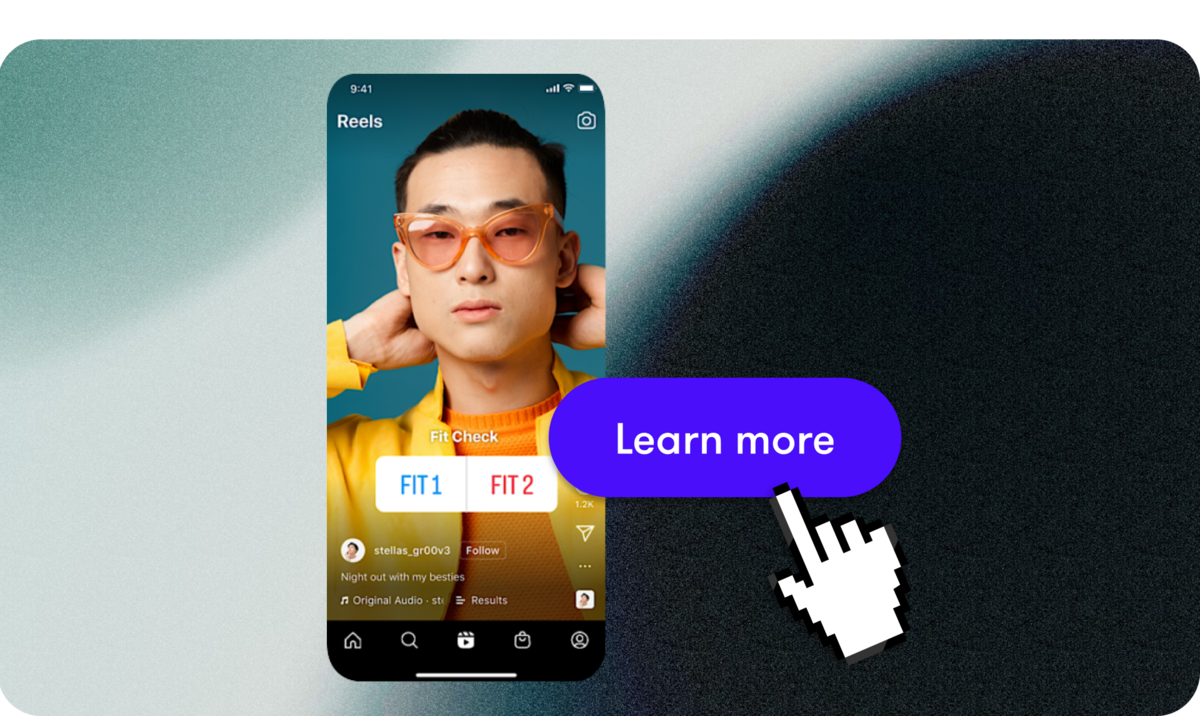
A compelling CTA leaves no room for ambiguity—it clearly states what you want the viewer to do and why they should do it.
A strong CTA encourages viewers to take immediate action, making your video ad a powerful tool for driving results and achieving your campaign objectives.
Placing CTAs strategically within the video ad
Strategic placement of CTAs within your video ad enhances their impact.
Here are some optimal positions to consider:
- Beginning: A CTA at the start of your video ad quickly establishes the action you want viewers to take. It’s especially effective for brand awareness campaigns.
- Middle: Placing a CTA midway through your video allows viewers to engage after they’ve been hooked by your content but before their interest wanes.
- End: The closing moments of your video are prime real estate for a CTA. Viewers who’ve engaged till the finale are more likely to take action.
- Throughout: In longer videos, consider placing CTAs at multiple points. This allows viewers to engage at different stages based on their level of interest.
Examples of effective CTAs for different campaign objectives
- Brand awareness: “Follow us for more amazing content!”
- Engagement: “Like, share, and spread the inspiration!”
- Lead generation: “Sign up now to receive exclusive updates.”
- Conversions: “Shop now and enjoy 20% off your first purchase.”
Tailor your CTAs to align with your campaign’s specific goal. Use action verbs and create a sense of urgency to motivate viewers to take immediate action.
Measuring Video Ad Performance
Creating a successful video ad campaign is only half of the equation; understanding how your ad performs and resonates with your audience is equally vital.
Introduction to key performance indicators (KPIs) for video ads
Key performance indicators (KPIs) are the numbers or metrics that provide insights into the effectiveness of your video ad campaign. They help you measure whether your campaign is meeting, exceeding, or falling short of its goals and identify areas for improvement.
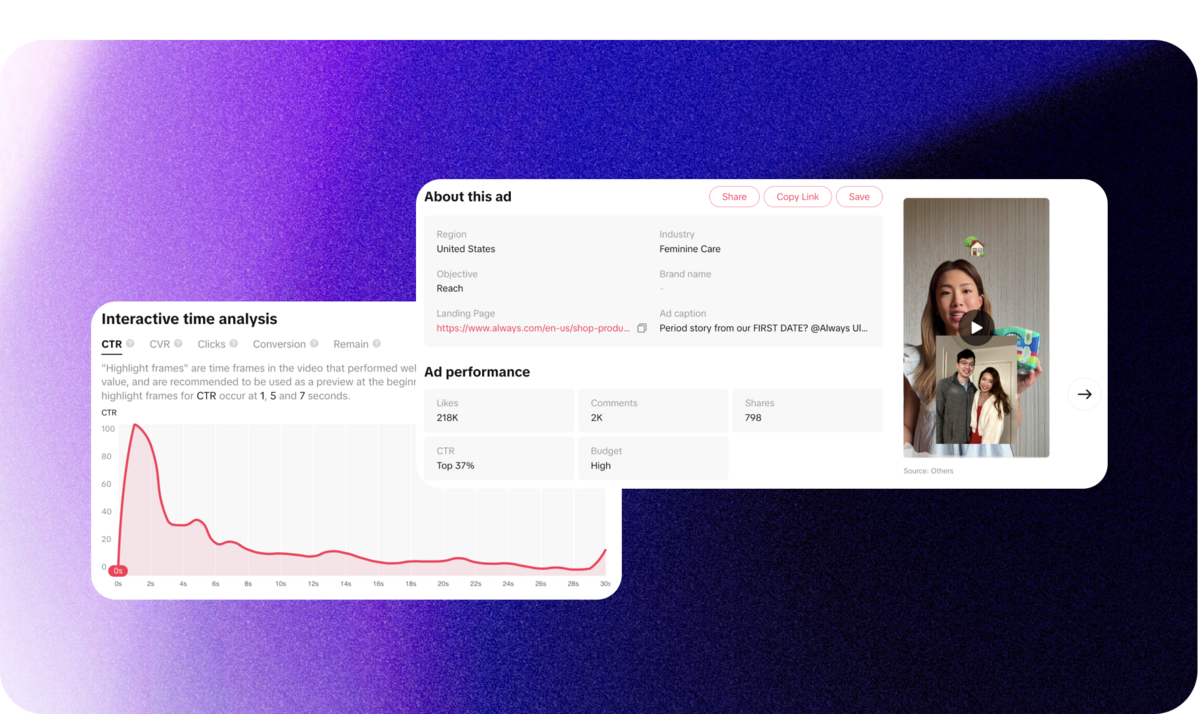
Different objectives warrant different KPIs, so it’s crucial to align your chosen metrics with your campaign’s purpose.
Ad performance metrics to track
- Views: The total number of times your video ad has been viewed. This metric gauges your campaign’s initial reach.
- Click-through rate (CTR): The percentage of viewers who clicked on your CTA relative to the total number of views. A higher CTR indicates a more engaged audience.
- Engagement metrics: These include metrics like likes, shares, comments, and interactions. Engagements show how well your content resonates with viewers.
- Conversion rate: The percentage of viewers who purchased or took the desired action (such as signing up or completing a quiz) out of the total number of views. This metric directly reflects your campaign’s impact on your bottom line.
- View duration: This is the average amount of time viewers spend watching your video. Longer view durations indicate high viewer interest.
- Bounce rate: The percentage of viewers who navigate away from your website shortly after clicking on your video ad. A lower bounce rate indicates effective landing page alignment.
Tools and platforms for monitoring and analyzing video ad metrics
- Google Analytics: A powerful tool that provides insights into website traffic, conversions, and user behavior.
- Social media analytics: Platforms like Facebook, YouTube, and Instagram offer detailed analytics on video ad performance, including engagement metrics and demographic data.
- Third-party analytics tools: Tools like HubSpot, Sprout Social, and Hootsuite offer comprehensive social media analytics, helping you monitor campaign performance across multiple platforms.
- Video hosting platforms: Platforms like YouTube and Vimeo provide insights into view counts, watch time, audience demographics, and more.
A/B Testing and Optimization Strategies
Creating an effective video ad campaign is a journey of continuous improvement. A/B testing and optimization strategies play a pivotal role in refining your campaign’s performance and maximizing its impact.
The significance of A/B testing in refining video ads and campaigns
A/B testing, also known as split testing, involves comparing two versions of an element to determine which performs better.
In the context of video ads, A/B testing is invaluable for understanding viewer preferences, identifying what resonates with your audience, and optimizing your campaign for better results.

A/B testing provides data-driven insights that enable you to make informed decisions, refine your strategy, and allocate resources more effectively.
Video ad elements to test
- Headlines: Test different headlines to discover which ones generate higher click-through rates and engagement.
- Visuals: Experiment with various visuals, such as video thumbnails or scenes, to see which ones capture viewer attention more effectively.
- Call-to-actions (CTAs): Test variations of your CTAs to determine which wording and placement encourage more conversions.
- Targeting: Adjust your audience targeting parameters to test which demographics or segments respond better to your video ad.
- Video length: Test different video lengths to find out whether your audience prefers shorter, attention-grabbing ads or longer, more informative content.
Optimization process for improving ad performance
- Hypothesis: Begin with a clear hypothesis about what you want to test and the expected outcome.
- Implementation: Create two versions of your video ad—one with the element you’re testing and the other with the alternative.
- Testing: Run the A/B test with a subset of your audience. Ensure that you’re testing one variable at a time to measure and record its impact accurately.
- Data analysis: Gather and analyze the data. Identify the version that performs better based on the chosen metric (clicks, views, conversions, etc.).
- Implementation of findings: Apply the insights gained from the test to the next iteration of your video ad. Implement the winning variation and adjust your strategy accordingly.
- Continued testing: A/B testing is an ongoing process. Continuously test and optimize different elements to refine your campaign and stay ahead of changing audience preferences.
Case Studies of Successful Video Ad Campaigns
Airnex and Billo’s Amazon Ads Strategy
Airnex successfully collaborated with Billo to efficiently create high-quality Amazon video ads for their new product launches, achieving impressive ROAS and addressing the challenges they faced with other production methods.
Objectives: Airnex sought an efficient source of Amazon video ads for each new product launch. They engaged with Billo periodically, typically when launching new products. The primary strategy involved creating at least 3 new ads for A/B testing to determine the most effective ad for product launches.
Challenges: Airnex required a quick and straightforward method for optimizing Amazon listings. The in-house ad production process was slow and time-consuming. Other options for creating Amazon ads were not scalable.
Solutions: Amazon ads achieved an Advertising Cost of Sale (ACOS) between 18-28%. Return on Advertising Spend (ROAS) ranged from 3.2 to 5.3.
Find out how else Billo benefitted Airnex and read the entire Airnex and Billo case study. More Billo case studies can be found here.
Peejamas and Billo’s Paid Media Campaigns
Peejamas successfully partnered with Billo to find niche creators and create engaging, cost-effective custom video ads for their Facebook campaigns. This approach outperformed expensive agency-produced ads and addressed challenges in finding the right creators and cost-efficient ad production.
Objectives: Peejamas aimed to showcase their niche product to young mothers. They collaborated with young mother creators, providing them with sample products.
The brand ordered 8 affordable custom video ads to use in their Facebook ad campaigns.
Challenges: It was challenging to find niche creators (young mothers) on other platforms.
Producing agency-quality ads was expensive. The ad production process was slow.
Solutions: Billo helped Peejamas find niche creators who could produce custom video ads with specific scripts. The Billo ads achieved an “Above average engagement rate” on Facebook ads. An ad costing $59 on Billo outperformed a $5,000 professionally produced video ad.
Discover how else Billo boosted Peejamas and read the whole Peejamas and Billo case study. More Billo case studies can be found here.
Ethical Considerations in Video Advertising
As video advertising continues to evolve, it’s imperative to uphold ethical standards that respect consumer privacy, cultural sensitivities, and honesty.
Addressing privacy concerns and data collection
Always be aware of informed consent. When collecting user data for ad targeting, ensure users are aware of the data being collected and how it will be used. Obtain explicit consent before utilizing their information.
Data security is part of any successful ad campaign. Safeguard user data against breaches or misuse. Be sure to implement adequate security and authentication measures to protect sensitive information.
Correct targeting, avoiding children, and NSFW
Ensure your targeting aligns with user preferences and respects their privacy. Avoid intrusive or irrelevant ads that can feel invasive.
When targeting children (if you must), ensure your content is appropriate for their age group and complies with relevant laws like the Children’s Online Privacy Protection Act (COPPA).
In general, outside of the extremely niche situations, it’s best to stay clear of NSFW content. Avoid using inappropriate or offensive content that might be unsuitable for specific audiences. Adhering to family-friendly content guidelines helps maintain a positive brand image.
Creating transparent and honest video ad content
It’s wise to represent your product or service accurately in your video ad. Misleading or exaggerated claims erode consumer trust.
It’s also smart to clearly disclose any sponsored or promotional content to viewers. Transparency builds credibility, and fosters trust.
Maintaining brand reputation and consumer trust
Reputation is everything in business, and there are three significant things to consider when it comes to building and maintaining public credibility:
- Consistency: Ensure that your video ad aligns with your brand values and messaging. Consistency across all touchpoints strengthens your brand’s reputation.
- Customer feedback: Pay attention to consumer feedback and criticism. Respond to concerns and address any issues promptly and professionally.
- Responsible content: Avoid controversial or offensive content that could tarnish your brand’s reputation. Maintain a positive online presence.
Drive Performance With UGC and Video Ads
Video ads and UGC are proven to be powerful tools for engaging audiences, conveying messages, and driving results. By understanding the psychology behind video advertising and the benefits it offers, you can harness its potential to connect with your target audience and achieve your marketing goals.
We have a whole guide on how to leverage UGC with your ads. Check it out here.
Video advertising remains a potent tool for engaging audiences and achieving marketing objectives. Apply the insights and strategies outlined in this article and begin creating effective video ad campaigns that captivate, connect, and convert viewers.
The future of video ads holds immense potential, and it’s a realm where creativity and strategy intersect to shape the marketing landscape. Start creating compelling (and effortless) video ads today with Billo and stay ahead in the ever-moving world of digital advertising.
Head of Content
After bouncing around tech start-ups and university literature programs, Joe has finally settled down as Billo’s Head of Content. Joe now spends his days writing ads about ads, teaching clients how to craft killer content, and combing through our web copy with a bold red Sharpie.

Authentic creator videos, powered by real performance data
22,000+ brands use Billo to turn UGC into high-ROAS video ads.
When to Trust Data-Driven Suggestions (and Whe...
Platforms, dashboards, and AI tools now shape nearly every marketing [...]...
Read full articleThe Power of Content Seeding: How to Plant Your ...
Content distribution has shifted — dramatically. Today, 70% of B2B [...]...
Read full article10 Common Digital Marketing Mistakes to Avoid in...
Digital marketing is fast, and what worked years ago might [...]...
Read full article



